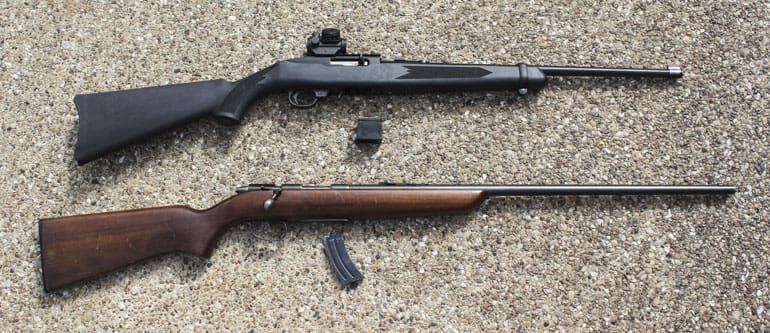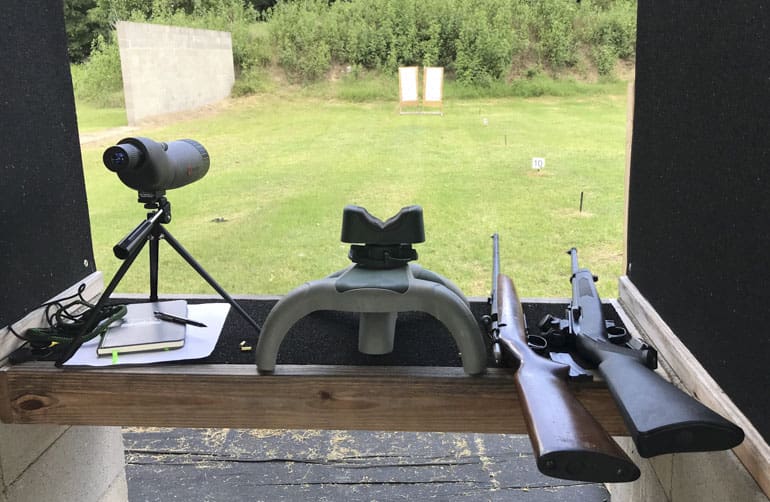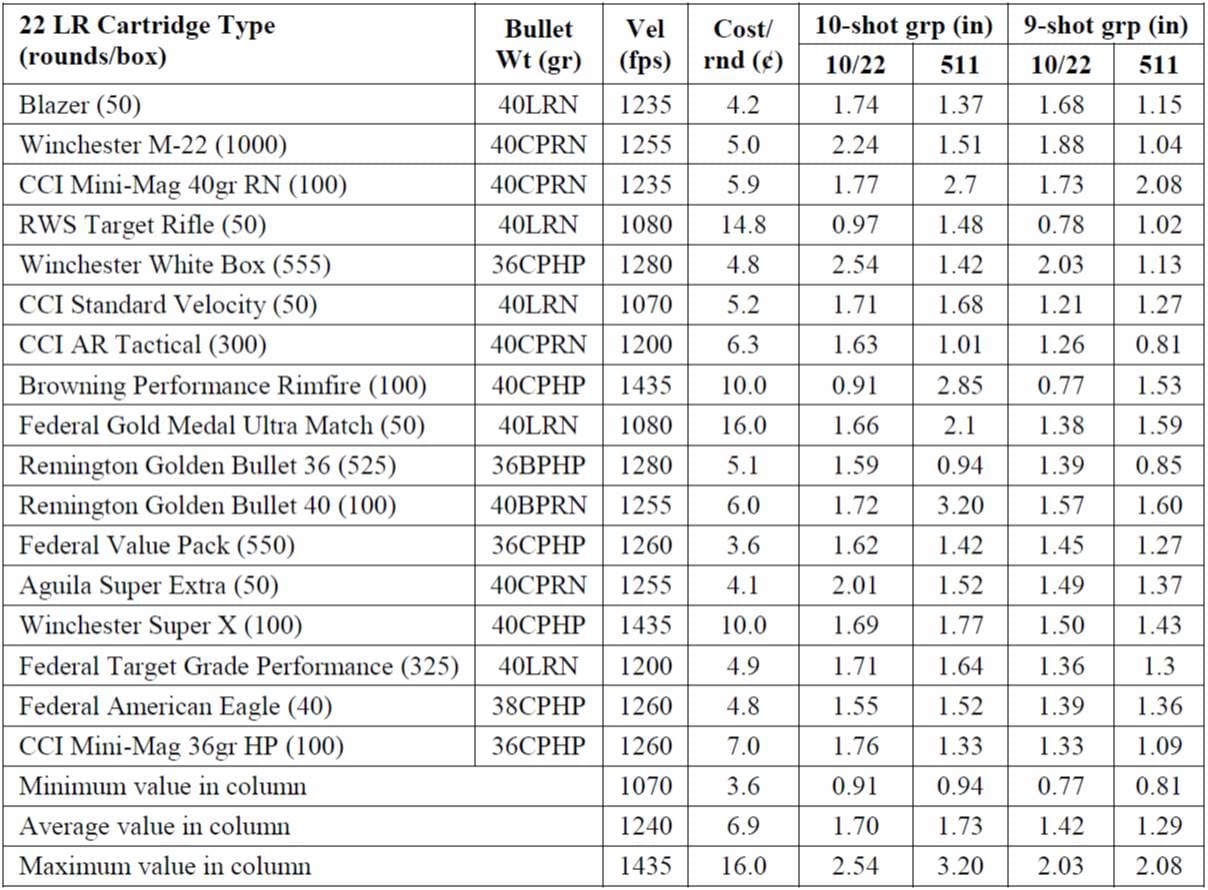By Thundervoice
The first gun I ever shot was a .22LR rifle. I remember that day well, as my Dad took me to a range when I as about nine and taught me how to shoot a Remington Model 511 that he acquired as a kid. It was a rifle which I still have and will pass on to my son someday. While I don’t shoot that rifle often, it is probably my favorite firearm.
Josh Wayner’s TTAG piece on 22LR reminded me of my stash of 22 ammo waiting to be used. I have enough 22 ammo now to be picky about what I buy in the future. The TTAG Summer Content Contest was just enough impetus for me to knock something off my “to do” list – have a “.22 shoot-off” competition so that I can make more informed decisions of which type of 22 ammo I should buy the next time I feel like restocking my stash.

The premise of my shoot-off was simple. I wanted to shoot each type of .22 ammo that I have in my stash to see which is the most accurate with two different rifles. As my sentimental favorite firearm, there was no doubt that the Remington Model 511 would be one of the rifles. That rifle has a 25 inch barrel, 16:1 twist, and open sights.
Since Josh said that the “Ruger 10/22 rifle is probably the most popular single 22 rifle ever made,” I figured that would be a good choice for the second rifle. My 10/22 has a 20 inch barrel, 15:1 twist, and a Bushnell TRS-25 red dot sight.
I decided to shoot 10 rounds of each ammo type with each rifle, using a dedicated target for each rifle and ammo combination. With 17 different types of ammo, that made for 34 targets, 340 rounds, and about 2.75 hours of shooting on a hot Texas Saturday at the range.

While I can typically shoot a six-inch or better group at 100 yards with the Model 511, I elected to shoot the rifles at 25 yards to keep the group sizes smaller and make it easier to use the open sights on the Model 511. At almost 60 years of age, I’ve had to go to monovision with my contacts, which makes shooting with open sights more challenging that it was in my younger days.
I shot from a sitting position using a support for the forestock. I would shoot 10 rouinds of a given type with the Ruger, then 10 rounds of the same type with the Remington. I would then reload the magazines of each with the next ammo type, then pull a BoreSnake through each barrel before starting the next round of shooting.
The cycle for a given ammo type was about seven minutes except when I had to reset targets. This rate kept the barrels from getting too hot, even with an ambient temperature that started at 90 degrees and climbed from there. I could set targets for six ammo types each trip downrange, which meant I had to go downrange three times. I shot 10 rounds through each rifle before starting with the actual shoot-off so that the barrels would not be cold for the first round.
The ammo used in the experiment was purchased at various times from various locations at various prices over the last 3.5 years. Most came from either Wal-Mart, Academy, or Gander Mountain (especially during their liquidation sale). I decided to randomize the shooting order so as to not favor any particular ammo type.
The table below shows the ammo types listed in the order in which they were shot, along with advertised velocity, bullet weight, cost/round, and the 9- and 10-shot group sizes.

A few notes about the information in this table. The ammunition types listed are not intended to be an all-inclusive list of .22LR ammo, it’s just want I had on hand. The bullet type indicated the weight in grains and two other features: 1) whether it was copper plated (CP) or lead (L) and 2) round nose (RN) or hollow point (HP). The Remington golden bullets are brass plated (BP). The Winchester M-22 bullets are black copper plated. The velocity was taken from the packaging or looked up on the manufacturer’s website.
The cost per round was determined by selecting the lowest costs from websites or my local Wal-Mart on July 13, 2018. I checked prices on the Academy Sporting Goods, Ammunition Depot, Bud’s Gun Shop, Cabelas, and MidwayUSA websites. Bud’s was the closest to having all of the ammo types on my list and generally had the lowest prices. Packaging quantities (rounds/box) varied from 40 round to 1000 round boxes as shown with the cartridge type in the table and reflects both what I shot and the basis for the cost/round. The 10-shot spread is the largest distance between any 2 of the 10 shots.
The trigger pull on the Model 511 is noticeably lighter than the 10/22 and that resulted in at least two flyers, so I used the nine-shot spread for evaluating the relative accuracy of the different types of ammo. These results indicate that the bolt action rifle with the longer barrel (Remington Model 511) was generally more accurate than the Ruger 10/22, based on the average group size of the 9-shot string, although it is worth noting that the smallest groups were shot with the Ruger.
There were no failure-to-fire, failure-to-feed, or failure-to-eject rounds with any of the 340 rounds shot. This is most likely due to shooting only 10 rounds of each ammo type in the semi-auto rifle. In my .22 steel competition experience, it’s not unusual for me to experience one or two FTFs during a competition (around 125-150 rounds). This varies depending upon the ammo used. While I have my preferences to avoid FTFs, I don’t have hard data and don’t want to put anecdotal data in print.
The second table shows the results sorted by group size (nine-shot spread in inches) for each rifle. Only two of the nine-shot groups were over two inches (barely) and only eight were between 1.5 and 2 inches. The other 24 nine-shot groups were all less than 1.5 inches (5.75 minutes of angle).

As can be seen in the second table, there are differences in the order of the ammo types. The CCI AR Tactical, RWS Target Rifle, and CCI Mini-Mag HP were in the top five of both groups.

The photo of the targets shows the results for these three ammo types for both rifles. The grid shown on these targets is one inch.
There were also some significant differences in the performance order. For example, the Remington M-22, which is the round I have been using in .22 steel competitions lately, was in the top five for the 511 but next to last with the 10/22 and the WWB ammo had a similar relationship. The Browning Performance Rimfire was at the top with the Ruger 10/22, but near the bottom of the list for the Remington 511. I’m guessing that the inconsistency in these rankings is partly due to inconsistency of the human shooter (me).
Although not presented here, I also sorted the results by the 10-shot spread. The order changed quite a bit for a few of the ammo types.
For the Ruger, the average difference between the 9- and 10-shot groups was about a quarter-inch, with a maximum difference of about a half-inch. In comparison, the average difference for the Remington 511 was about a half-inch, with a maximum of 1.6 inches.
The larger differences with the Remington are due to two ammo types (Browning Performance Rimfire and Remington Golden Bullet 40gr) where I shot a flyer with the 511 rifle (most likely due to the lighter trigger on the 511). If I delete those ammo types from the statistics, the averages and maximums for each rifle are close.
One of the more accurate rounds was the RWS Target Rifle. This ammo is German-made and costs almost 15 cents/round (top targets in photo). If I remember correctly, I bought a handful of boxes at Gander Mountain during their liquidation sale without any idea whether it was worth buying. On the other hand, the most expensive ammo, Federal Gold Medal Ultra Match, at 16 cents/round, did not produce as small a group as several of the other ammo types.
So what did I learn from this experience?
- Perhaps the most important is that a one-inch group at 25 yards is almost four minutes of angle. This level of accuracy is laughable for most rifles. I’m confident that I could shoot tighter groups with my rifles if I used a steadier support, including support near the rear of the rifle. The4 MOA I got at 25 yards is better than the six-inch group I often shoot at 100 yards (6 MOA). While 3 MOA accuracy is nothing to brag about, remember that we are talking about 22 ammo and unmodified rifles.
- Now that I have done this once, I’ll repeat it again in the future, although maybe not with all 17 types in one sitting. The next time I do this, I want to borrow a lead sled or a similar rest to see how much difference that makes.
- I did not report this in the results, but there were some significant differences in the point of impact between the different types of ammo. This is likely due to the different velocities and bullet weights (duh!) but the relationship between POI and velocity/weight were not obvious when I analyzed the data. The differences between POI might also be related to differences between advertised velocity and the actual velocity out of a given barrel. Given that there was a five-inch difference in barrel lengths, I would expect the velocities with each rifle to be different. I did not measure velocity but that would be good information for someone to add to this database if anyone wants to take on that effort.
- There were some fairly significant differences in the groups with each rifle. This may be due to the fact that I shot a little faster with the 10/22 due to it being a semi-auto and that the red dot made sighting a little faster. It is also worth noting that the red dot for the Bushnell sight is a 3 MOA dot so the average group size for the 10/22 is only about a half inch larger than the size of the red dot.
- It took almost three hours of shooting to go through all 17 types of ammo. That’s a lot of time hunched over a couple of rifles. I felt like I was not shooting as well toward the end, but when I look at the results, several of the larger groups were in the top five types of ammo in the evaluation. So it may be that I hadn’t warmed up at the beginning and that the ammo types shot at the beginning would have better results if they had been shot later in the day.
- The signs of variability that I have mentioned above indicate that there is more work to be done to identify the best cartridge for a given firearm. With this information as a base, I can keep better notes the next time I do some precision shooting with either of these rifles.
- I shoot in 22 steel competitions on occasion and enjoy shooting my 22 at the range on occasion. I don’t shoot my 22 as much as I used to now that I reload my other calibers, but shooting the 22 is still a lot of fun, especially trying to get a small group at 100 yards. Over the last few years, I have noticed differences in accuracy between cheaper plinking ammo and more expensive target ammo. I have also noticed failure-to-fire events during 22 steel competitions with some of the ammo types I use. I need to keep better notes on the rounds used and FTF in future competitions.
- For the most part, I can continue to use the same ammo for the steel competition in my Ruger 10/22. Those are generally the CCI AR Tactical, CCI Mini-Mag HP and Remington Golden Bullet 36 pt HP. These competitions are timed events shooting at large steel targets, so speed is more important than precise accuracy.
- The love for my Remington Model 511 was reaffirmed. I’m looking forward to using it next month in a long-range rimfire silhouette contest (not a speed event). With the information from my experiment, I know I’ll be using the remaining stock of my RWS ammo for that competition.
via The Truth About Guns
.22LR Ammunition Shootout: Two Rifles, 17 Brands
